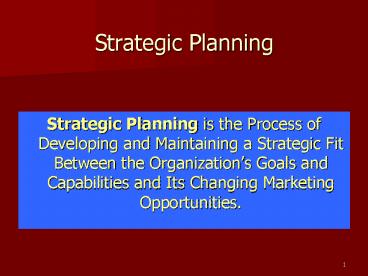Strategic Planning - PowerPoint PPT Presentation
1 / 34
Title:
Strategic Planning
Description:
Rocking the Boat. Follow. Closely. Follow at a. Distance. Market Follower ... areas inside a company that have an impact on the marketing department's plans. ... – PowerPoint PPT presentation
Number of Views:68
Avg rating:3.0/5.0
Title: Strategic Planning
1
Strategic Planning
- Strategic Planning is the Process of Developing
and Maintaining a Strategic Fit Between the
Organizations Goals and Capabilities and Its
Changing Marketing Opportunities.
2
Steps in Strategic Planning
Business unit, product, and market level
Corporate Level
Planning, marketing, and other
functional Strategies
Setting Company Objectives and Goals
Defining the Company Mission
Designing the Business Portfolio
3
The Strategic-Planning, Implementation, and
Control Process
4
Corporate and Division Strategic Planning
- All corporate headquarters undertake four
planning activities - Defining the Corporate Mission
- Establishing Strategic Business Units (SBUs)
- Assigning resources to each SBU
- Planning new businesses, downsizing, or
terminating older businesses
5
Defining the Companys Business and Mission
A Mission Statement is a Statement of the
Organizations Purpose.
6
Designing the Business Portfolio
- The business portfolio is the collection of
businesses and products that make up the company. - The company must
- analyze its current business portfolio or
Strategic Business Units (SBUs) - decide which SBUs should receive more, less, or
no investment - develop growth strategies for adding new products
or businesses to the portfolio
7
Corporate and Division Strategic Planning
- Three characteristics of SBUs
- Single business or collection of related
businesses that can be planned for separately - Has its own set of competitors
- Has a manager who is responsible for strategic
planning and profit
8
Analyzing Current SBUs The Boston Consulting
Groups Growth-Share Matrix
9
Analyzing Current SBUsGEs Strategic
Business-Planning Grid
Business Strength
Strong
Average
Weak
C
High
A
Medium
Industry Attractiveness
D
B
Low
10
Five Forces Determining Segment Structural
Attractiveness
11
Three Intensive Growth Strategies Ansoffs
Product-Market Expansion Grid
12
The Marketing Process
Demographic- Economic Environment
Technological- Natural Environment
Marketing Intermediaries
Publics
Suppliers
Political- Legal Environment
Social- Cultural Environment
Competitors
13
The Marketing Process
- The Value Delivery Sequence
Two Views of the Value-Delivery Process
14
Connecting With Customers
- Market Segmentation determining distinct groups
of buyers (segments) with different needs,
characteristics, or behavior. - Market Targeting evaluating each segments
attractiveness and selecting one or more segments
to enter. - Market Positioning arranging for a product to
occupy a clear, distinctive, and desirable place
relative to competing products in the minds of
target consumers.
15
Steps in Analyzing Competitors
Identifying the companys competitors
Assessing competitors objectives,
strategies, strengths and weaknesses, and
reaction patterns
Selecting which competitors to attack or avoid
16
Identifying Competitors
- Number of Sellers and Degree of Differentiation
- Pure monopoly
- Oligopoly
- Pure oligopoly
- Differentiated oligopoly
- Monopolistic competition
- Pure competition
17
Competitor Map Eastman Kodak
18
Analyzing Competitors
- Three Variables to Monitor When Analyzing
Competitors - Share of market
- Share of mind
- Share of heart
19
Basic Competitive Strategies
Overall Cost Leadership
Focus
Differentiation
Middle of the Road
20
Competitive Strategies Value Disciplines
Companies Gain Leadership Positions by Delivering
Superior Value to their Customers Through These
Strategies
21
Hypothetical Market Structure
10 Market Nichers
20 Market Follower
30 Market Challenger
40 Market Leader
22
Competitive Marketing Strategies
23
Specific Attack Strategies
- Price discounts
- Lower-priced goods
- Value-priced goods
- Prestige goods
- Product proliferation
- Product innovation
- Improved services
- Distribution innovation
- Manufacturing-cost reduction
- Intensive advertising promotion
24
Competitive Marketing Strategies
25
Market Follower Strategies
Counterfeiter
Cloner
Imitator
Adapter
26
The Marketing Process
Demographic- Economic Environment
Technological- Natural Environment
Marketing Intermediaries
Publics
Suppliers
Political- Legal Environment
Social- Cultural Environment
Competitors
27
The 4 Ps 4Cs of the Marketing Mix
- 4 Ps
- Product
- Price
- Place
- Promotion
- 4 Cs
- Customer Solution
- Customer Cost
- Convenience
- Communication
28
The Marketing Process
Demographic- Economic Environment
Technological- Natural Environment
Marketing Intermediaries
Publics
Suppliers
Political- Legal Environment
Social- Cultural Environment
Competitors
29
Marketing Environment
- Marketing Environment- consists of the actors and
forces outside marketing that affect marketing
managements ability to develop and maintain
successful relationships with its target
customers. - Includes
- Microenvironment - forces close to the company
that affect its ability to serve its customers. - Macroenvironment - larger societal forces that
affect the microenvironment.
30
The Companys Microenvironment
- Companys Internal Environment- functional areas
inside a company that have an impact on the
marketing departments plans. - Suppliers - provide the resources needed to
produce goods and services and are an important
link in the value delivery system. - Marketing Intermediaries - help the company to
promote, sell, and distribute its goods to final
buyers. i.e. resellers.
31
The Companys Microenvironment
- Customers - five types of markets that purchase a
companys goods and services. - Competitors - those who serve a target market
with similar products and services against whom a
company must gain strategic advantage. - Publics - any group that perceives itself having
an interest in a companys ability to achieve its
objectives.
32
Major Forces in the Companys Macroenvironment
33
Managing the Marketing Effort
Marketing Analysis of Companys Situation
Control
Marketing Planning Develop Strategic Plans
Develop Marketing Plans
Marketing Implementation Carry
Out The Plans
Measure Results
Evaluate Results
Take Corrective Action
34
Contents of a Marketing Plan
Executive Summary
Current Marketing Situation
Threats and Opportunity Analysis
Objectives and Issues
Marketing Strategy
Action Programs
Budgets
Controls































